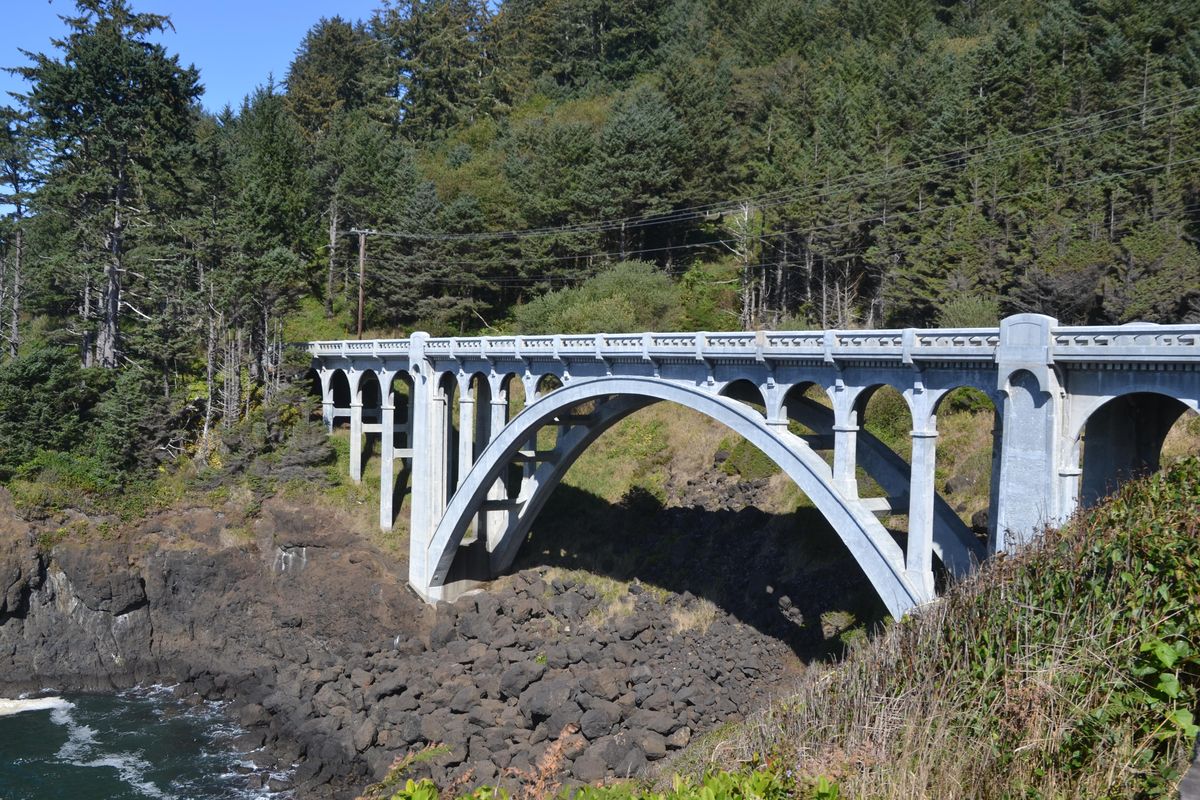Travel: On the Oregon Coast, bridges lead to the past

The Oregon Coast has so many attractions, it’s easy to miss some that are right under your feet, or, more precisely, under your vehicle’s wheels.
Along the Oregon Coast on the Pacific Coast Highway 101, there are 11 historic and beautiful bridges that deserve to be explored and photographed. These bridges, built in the 1920s and ’30s, helped connect the small coastal communities that were growing at the time, thanks to fishing and timber opportunities.
Before the bridges, towns were isolated because of the rocky but stunning shoreline. Access was by boat, ferry or along the beach at low tide using horses and wagons. Many rivers, bays, canyons, thick undergrowth and timber made a coastal road a forminable undertaking.
In 1919, the Oregon Department of Transportation created a bridge division and hired an engineer, Conde B. McCullough. He led the charge to build a road and bridges the entire length of the Oregon Coast – 400 miles from the Columbia River to California.
One of McCullough’s strengths was his conviction that engineering and aesthetics can coexist. His bridges feature reinforced-concrete deck arches, paired arch ribs, doubled-tiered viaducts and other things that were new to the United States at the time. They also feature decorative elements, like Egyptian obelisks and art deco details.
After crossing several of the bridges, the iconic design McCullough used – concrete arches and steel arched spans become recurring and familiar. Each bridge seems to tie the entire coastal road together.
Here are four bridges along Oregon Highway 101 that deserve to be explored and admired.
Yaquina Bay Bridge: You can’t miss this bridge when visiting Newport’s historic waterfront. The bridge looms toward the west over the docks, crab baskets and the fishing boats. It was built in 1936 with a 3,223-foot-long span. The bridge has five concrete arches and two steel deck arches with the crown arch 246 feet above sea level. Approaching and crossing the bridge is an adventure in itself. The lofty view of Newport, Yaquina Bay and the Pacific Ocean is stunning.
Depoe Bay Bridge: The small town of Depoe Bay entices tourists to stop and is known for its clam chowder, world’s smallest bay, whale-watching center and huge waves crashing over the highway during winter storms. The short bridge over the entrance of the bay with traffic passing over seems unremarkable. It isn’t. Since you have stopped, walk over to the bridge where steps will lead under the bridge. A view emerges of the concrete arches, view of the fishing boats moored in the small bay and the ocean waves breaking into the entrance. The single-lane bridge was built in 1927. An identical bridge was built in 1940 beside the original because of increased travel.
Rocky Creek Bridge: Also known as the Ben Jones Bridge, it has been bypassed by a newer, straighter Highway 101. It is accessible on the Otter Crest Loop road 1/10 mile from the north junction from Highway 101. There is a pull out with parking and a good view of the bridge with its now familiar concrete arches supporting the deck. An interpretive sign explains who Ben Jones was and his contribution to the highway construction. Another sign explains how the Oregon Highway Department is trying to protect the concrete in the bridges from the corrosive salty sea water it is exposed to on a regular basis. The bridges are being treated with zinc cathodic protection. Another sign explains how this electrical/chemical process works.
Cape Creek Bridge: The bridge was built in 1932 and provides access to one of the most scenic areas along the Oregon coast. The Heceta Head Lighthouse State Scenic Viewpoint is close to the iconic most photographed lighthouse on the Oregon coast. The light was constructed high on a promontory point extending out into the ocean along with a light keepers two-story house. The best places to view the bridge is the lighthouse parking lot below and on the sandy beach of the creek as it meets the ocean. Looking back and up at the bridge from below will be reminiscent of a Roman aqueduct with repeating concrete arches. Sea Lion Caves is nearby. As if this not enough attraction for one place, the light keeper’s house is a bed and breakfast available to the public.
McCullough Memorial Bridge: Located just North of Coos Bay and spanning a mile across the water, this bridge was built in 1936 and, at the time, was the longest bridge in Oregon. Locals still call it the Coos Bay Bridge. Even today the bridge is striking. It may take an engineer to understand construction of a steel continuous cantilevered half-through truss with bracing above and below the deck. But the artistic design of the bridge needs no explanation. McCullough’s iconic intention is obvious. There are seven reinforced concrete deck arches on the north side of the bridge with six on the south side like a string of the pearls connecting with two steel slopping spans in the center. The repeating design seems to complement the distant mountains.